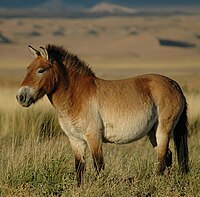
Photo from wikipedia
Among the animal species first introduced in Brazil during the country's discovery, horses (Equus caballus) stand out because of their evolutionary history and relationship with humans. Among the Brazilian horse… Click to show full abstract
Among the animal species first introduced in Brazil during the country's discovery, horses (Equus caballus) stand out because of their evolutionary history and relationship with humans. Among the Brazilian horse breeds, the Pantaneiro draws attention due to its adaptative traits. Blood samples of 116 Pantaneiro horses were divided into six populations based on their sampling location, aiming to identify the existence of genetic structure and quantify genetic diversity within and between them. Populations were compared to elucidate genetic variability and differentiation better and assess the impact of Pantanal's natural geographic barriers on gene flow between populations. Data from the GGP Equine BeadChip (Geneseek-Neogen, 65.157 SNPs) was used to assess basic diversity parameters, genetic distance (FST), principal component analysis (PCA), and population structure (ADMIXTURE) for the sampled animals. Mantel test was also performed to investigate the correlation between the populations' genetic and geographic distances. Results showed high genetic variability in all populations, with elevated levels of admixture in their structure. High levels of admixture make it challenging to establish a racial pattern and, consequently, populations within the breed, being that only one of the populations differentiated itself from the others. No significant correlations between genetic and geographic distances were observed, indicating that environmental barriers did not hinder gene flow between populations, and neither farmers' selection practices might have change breed genetic composition significantly. Low genetic distance and similar heterozygosity values were observed among populations, suggesting strong genetic proximity and low differentiation. Thereby, the Pantaneiro breed does not exhibit genetic subpopulations and could be considered, for conservation purposes, a single big population in the Panatnal region. This study will support sampling strategies for National genebank.
Journal Title: Tropical animal health and production
Year Published: 2021
Link to full text (if available)
Share on Social Media: Sign Up to like & get
recommendations!